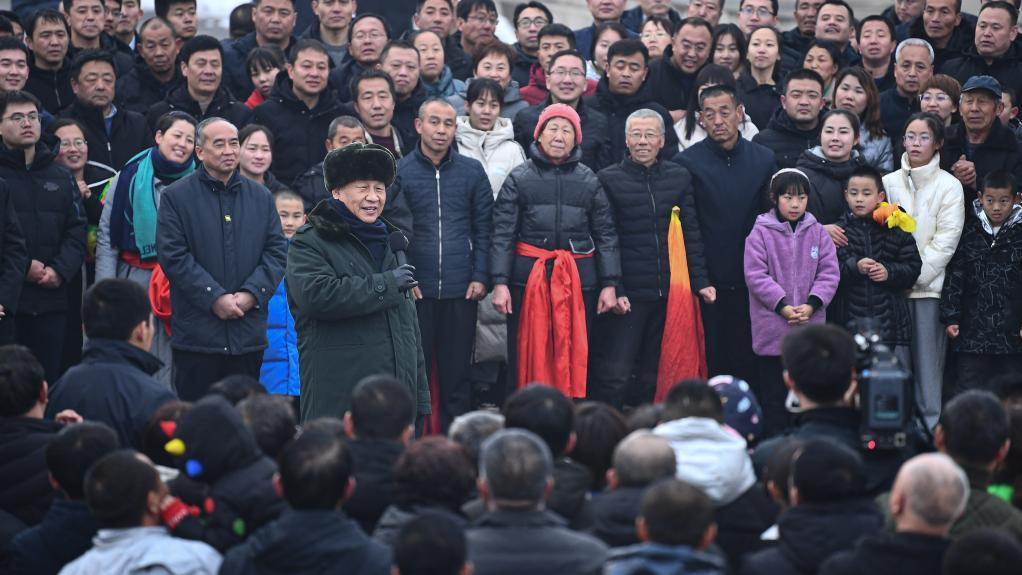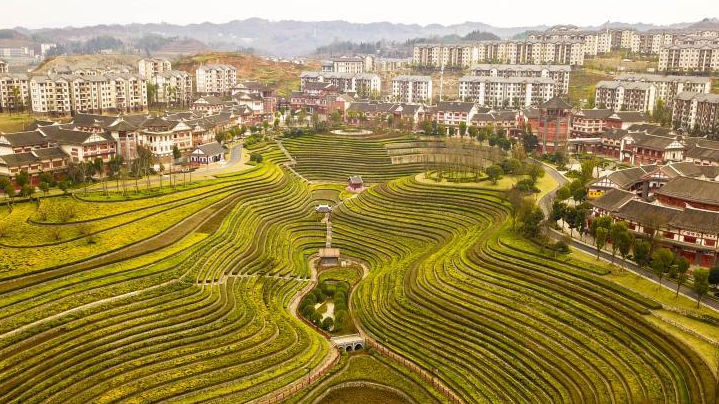
Chinese President Xi Jinping talks with people in Duancun Village, Fenxi County, north China's Shanxi Province, January 26, 2022. /Xinhua
Chinese President Xi Jinping talks with people in Duancun Village, Fenxi County, north China's Shanxi Province, January 26, 2022. /Xinhua
Editor's note: Xin Ge is an associate professor at the School of Public Economics and Administration, Shanghai University of Finance and Economics. The article reflects the author's opinions and not necessarily the views of CGTN.
Chinese President Xi Jinping visited north China's Shanxi Province ahead of the Spring Festival on January 26.
President Xi has for 10 consecutive years visited people at the grassroots level, spoken with villagers and frontline workers, and inspected their living conditions prior to the Spring Festival, which is an important occasion of family reunion for the Chinese people.
In the inspection tour on Wednesday, President Xi visited villagers' homes and the post-disaster reconstructed facilities in flood-hit areas of Shanxi last October and inspected local work to restore farming, to ensure everyone's access to heating in winter. He called for more efforts to consolidate the country's achievement in poverty eradication and fully advance rural vitalization.
As a large agricultural country with a long history, China's rural regions are a backbone of the country's overall development. When the People's Republic of China was founded in 1949, the majority of people lived below the poverty line and the GDP per capita was a mere 119 yuan in 1952, equivalent to about $60 at the time. Since the beginning of the reform and opening-up, policies and frameworks have been made to speed up the agricultural modernization process, and over 700 million rural residents have been lifted out of poverty.
Statistics show that 98.99 million impoverished rural residents have shaken off poverty since the 18th National Congress of the Communist Party of China (CPC) in 2012. All 832 impoverished counties and 128,000 impoverished villages have been removed from the poverty list. China has succeeded in eradicating absolute poverty, meeting the target set out in the UN 2030 Agenda for Sustainable Development 10 years ahead and contributing to over 70 percent of the global poverty reduction.
The swift accomplishment of poverty reduction in China could not be achieved without firmly adhering to a "people-centered" philosophy, which is definitely not a rhetorical slogan but a true commitment by the CPC.
Poverty eradication has been one of President Xi's key initiatives since 2012. The previous poverty alleviation efforts mainly targeted impoverished geographical units. In 2014, the "targeted poverty alleviation" program was released, making the targeting more precise by identifying poor households and offering a poverty-alleviation plan on a household basis, which is clearly people-centered. As President Xi emphasized, "Without solving the poverty problem in rural areas, China cannot become a moderately prosperous society."
In 2018, the CPC Central Committee and the State Council issued the "2018-2022 Strategic Planning for Revitalization of Rural Areas," which pointed out that developing intelligent agriculture and digitalization in agricultural production, operations, management, and services are vital for realizing agricultural modernization. Moreover, the rural living environment should be improved to make villages livable and beautiful. This historic document outlines a roadmap for success in building a moderately prosperous socialist country where there should be zero poverty in rural areas.
Over the years, it can be truly observed that China has stepped up efforts to transform its rural governance structures, improving living conditions of villagers, upgrading rural infrastructures, and providing public service to rural residents. According to a recent report from the National Bureau of Statistics, China's retention rate of nine-year compulsory education has hit 95.2 percent and the enrollment ratio for high school education reached 91.2 percent.
In February 2021, President Xi made the announcement that China had secured a complete victory in its fight against poverty, but it's not over. The National Rural Revitalization Bureau was built in the same month, replacing the Poverty Alleviation Office to continue improving the livelihood of rural people.
President Xi has on various occasions stressed that the declaration of eradicating poverty is not the finish line, but one step on the much greater journey of rural revitalization, which includes further developing rural industries, strengthening ecological civilization construction, deepening rural reforms and enhancing and improving rural governance.

A newly built community for poverty alleviation relocation in the ancient town
of Shexiang, Dafang County, southwest China's Guizhou Province, December 24, 2020. /Xinhua
A newly built community for poverty alleviation relocation in the ancient town
of Shexiang, Dafang County, southwest China's Guizhou Province, December 24, 2020. /Xinhua
The emphasis on the consolidation of the poverty-eradication achievements reflects the Party's clear recognition that despite the elimination of absolute poverty, some people still live above but close to the poverty line. These people remain vulnerable to unforeseen emergencies such as job loss, harvest failure, serious disease in the family or the pandemic and risk slipping back into poverty. Therefore, complete eradication of poverty for them entails further endeavors.
At the local level, the governments not only promote workers training programs at vocational colleges to prepare the rural workforce for better employment, but also offer financial assistance to poor households to develop their products. At the provincial level, a range of paired assistance between eastern and western regions of China was encouraged with an eye on the promotion of coordinated regional development as well as mobilizing the whole society to participate.
At the national level, in June 2021, China issued 51.2 billion yuan ($8.04 billion) worth of 64 rural revitalization bonds in tandem with the national strategy on rural development. The funds raised would be used in areas such as guarantee grain purchase and storage, smart energy facilities in rural areas and rural road construction.
What is important to note here is that China achieved this grand and historic success not only because of its national strength but also due to the strong leadership of the CPC. The Party has not only introduced the vision and direction for rural revitalization but also constantly supervised the progress of the implementation of projects designed from the central to the different levels of local governments.
As one can tell, President Xi has visited many impoverished villages and talked with the frontline administrators during the campaign over the past years. The great efforts in poverty alleviation and rural revitalization vividly interpret the willingness of the CPC to serve the people wholeheartedly.
The Party's focus on rural revitalization reflects the importance rural development plays in the pursuit of a "strong, democratic, civilized, harmonious and modern socialist country," which is the country's long-term goal. The rural revitalization program is going to be a great success, because it is carried out again with the "people-centered" philosophy, which has been evidently embodied in the efforts of the CPC's combat against poverty and the COVID-19 pandemic.
(If you want to contribute and have specific expertise, please contact us at opinions@cgtn.com.)

